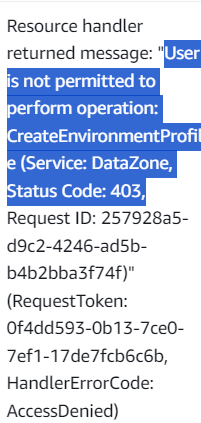1 Answer
- Newest
- Most votes
- Most comments
1
Hello,
As you might already know, when we create resources from a CloudFormation, we get an option to provide an IAM role for Cloud Formation to assume to spin up the resources. If not provided, the role that you are logged into the AWS console as will be used for this. If you are indeed passing a role to CloudFormation rto assume, can you please review that first.
Also, what you can do to troubleshoot is effectively is that you can navigate to the Cloud Trail console and compare the cloud trail event on the API call "CreateEnvironmentProfile" when it is being performed from console and from CFT. This might point us to any potential difference between the API calls.
Thank you!
answered 2 months ago
Relevant content
- asked a year ago
 AWS OFFICIALUpdated 2 years ago
AWS OFFICIALUpdated 2 years ago AWS OFFICIALUpdated 3 months ago
AWS OFFICIALUpdated 3 months ago
